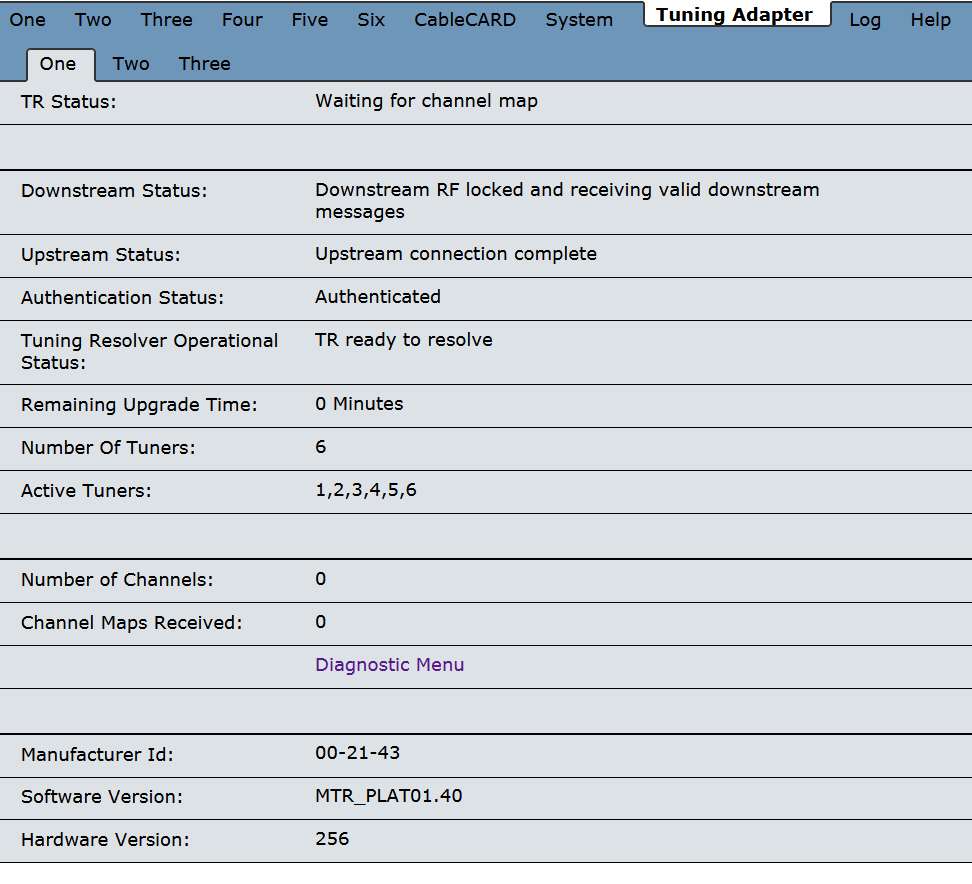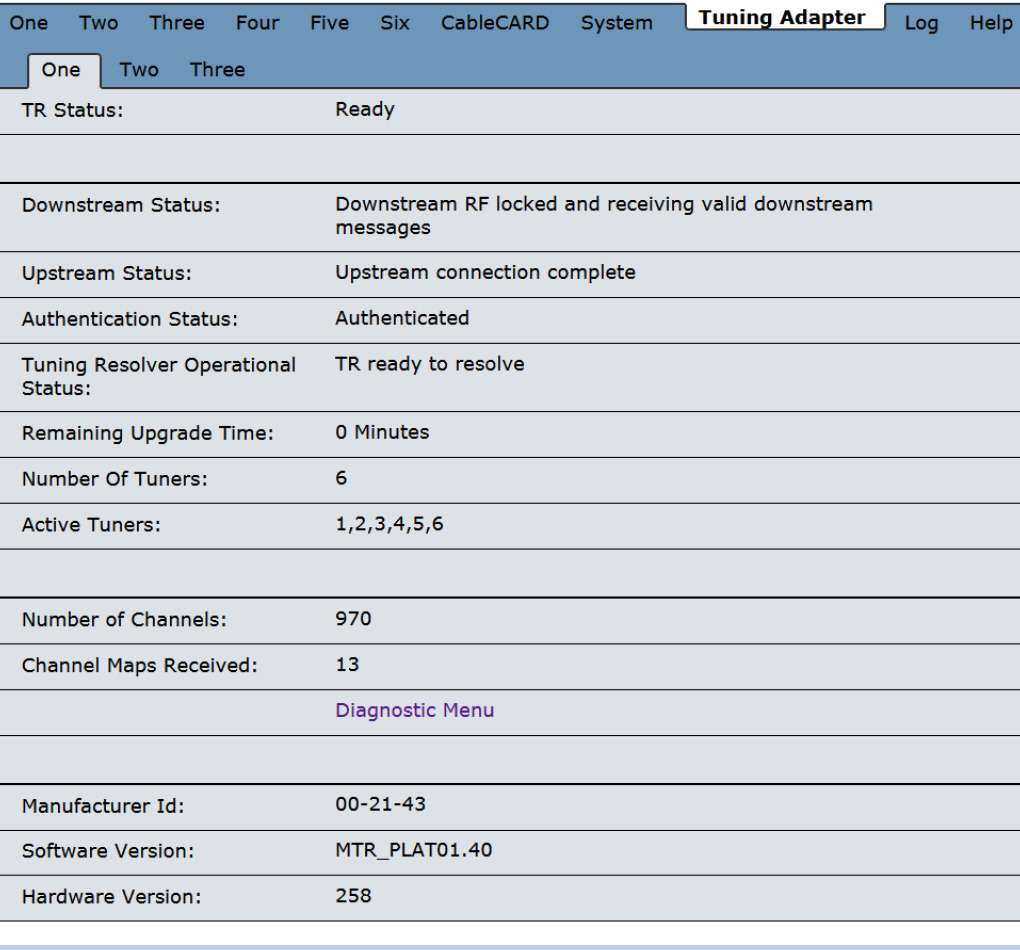Because of the two main "TV WMC nodes" in my house (requiring two coax runs to the two HTPCs) I have a primary splitter dividing the outside feed into the house. And many years ago Spectrum added an in-line amplifier to the primary coax cable (before the primary splitter), so that both feeds were sufficiently strong (since there were other downstream splitters for phone and internet).
Machine (2) Z170 is currently unable to tune any SDV-delivered channels, because the tuning adapter is not being initialized successfully for some reason. Instead, the Tuning Adapter tab of the web browser GUI shows "waiting for channel map" (and no channels or maps loaded) although everything else indicates 100% success.

In contrast, Machine (1) M910t works perfectly (almost... see below) as far as the tuning adapter is concerned. No problem tuning all SDV-delivered channels. And of course the Tuning Adapter tab of the web browser GUI looks perfect.

That's the problem. So is "waiting for channel map" a software problem on the Z170? Seems unlikely. Nothing at all has changed.
So if it's a hardware problem, what might it be? The tuning adapter on Z170 has been replaced but with no effect. Could possibly be a hardware malfunction with the Ceton ETH??
I had Spectrum out here for several hours today, trying to shoot the "waiting for channel map" problem along with another strange anomaly: channel 101 (USA, which is NOT SDV) can no longer be tuned at all on the M910t machine. And channel 101 can just barely be tuned on the Z170 (WMC keeps trying all 6 tuners until it finds one that works or they all fail, and almost always finds at least one that works... but tuner failures on channel are occurring all the time). They investigated the main feed from the outside, and determined it was VERY HOT signal strength. They've opened a ticket with outside maintenance line people, to get this addressed.
In response to the discovery of the "hot signal" he removed the in-line amplifier, saying it was obviously not needed and perhaps could be overloading both the tuning adapters and the Ceton tuners... perhaps explaining the channel 101 anomaly. This made no difference on M910t which still can't tune channel 101, and did improve Z170 which now seems to find a working tuner after only 2-3 tries (still not perfect, but much better than before since at least it "succeeds").
The Z170 machine was originally built in 2017 using an internal Ceton 6-tuner PCIe card until mid-2020 when the Ceton ETH was acquired (in order to support my project of having WMC running successfully in a VMWare Win7-VM guest machine under Win10 host). But normally the Z170 machine is booted to Win7, and has been running flawlessly that way for the past 4 years, originally with the Ceton PCIe card and then later with the Ceton ETH tuner, and always with the tuning adapter. Until just recently with this new "waiting for channel map" symptom.
I only began noticing both of these major problems this week, with the start of the Olympics and many hundreds of programs to be recorded across the 6 channels of the NBC family. It was the inability to record channel 101 (USA) on M910t that prompted me to try and deal with this problem by reactivating Z170 specifically to record just the Olympics programs airing on 101. So how long the "waiting for channel map" symptom on Z170 may actually have been present, I don't know. For sure it's certainly there now.
I've tried the usual kick-start workarounds, like reinstalling the 1088 Ceton software. No effect.
When time permits (and this may not occur until after the Olympics are over) I plan to swap the tuning adapters currently in use for the Z170 and M910t. If the "waiting for channel map" persists with the Z170 using the previously normal tuning adapter from the M910t, while the previously failing Z170 tuning adapter now works perfectly when used on the M910t, well that totally eliminates the tuning adapters as the possible hardware culprit. It would now likely point to either the Ceton ETH or some cabling issue relating to the Z170.
I'm desperately all ears, hoping somebody out there has similar experience with tuning adapters and whatever might be the underlying cause for "waiting for channel map"?
And how about that channel 101 mystery? Without the in-line amplifier, the M910t node (which has two splitters) produces a signal strength of about -11.5db (which is very low) and SNR of about 39db (which is very good). I'm going to try putting the in-line amplifier into this second split coax path out of the primary splitter, as this path with its two additional splitters needs a boost. Perhaps that may coax channel 101 back to "normalcy" for the M910t. As to why it's just channel 101, well that may be a Spectrum-related distribution problem on that channel frequency that I have no control over.
All of this may relate to the "hot signal" coming from the outside, which may have happened due to Spectrum outside work over the past 6 months.
Really distressing, as I have been running many WMC machines with Ceton 4-tuner and 6-tuner cards over the past 11 years since 2010, all truly flawlessly until now.
NEED HELP OR IDEAS!!


